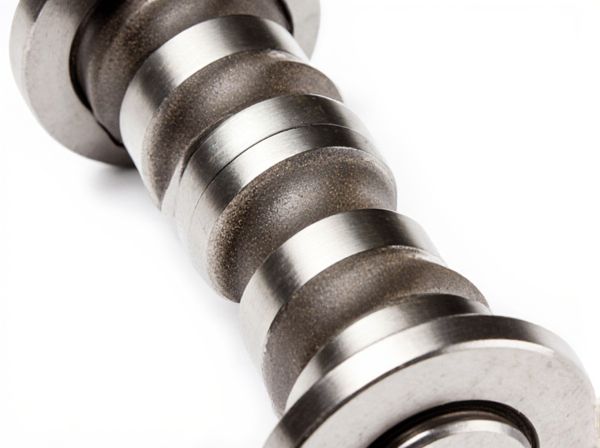
Photo illustration: Micro-Polished Crankshaft vs Non-Polished Crankshaft
A micro-polished crankshaft offers enhanced surface smoothness, reducing friction and wear compared to a non-polished crankshaft. This process improves engine efficiency and longevity by minimizing stress concentrations that can lead to cracks or failures. Your engine benefits from smoother operation and increased durability with a micro-polished crankshaft.
Table of Comparison
| Feature | Micro-Polished Crankshaft | Non-Polished Crankshaft |
|---|---|---|
| Surface Finish | Ultra-smooth, reduced surface roughness | Rougher surface, visible machining marks |
| Friction | Lower friction, improved engine efficiency | Higher friction, standard efficiency |
| Fatigue Resistance | Enhanced fatigue strength, longer lifespan | Standard fatigue strength, shorter lifespan |
| Wear Resistance | Improved wear resistance | Higher wear rates over time |
| Engine Performance | Smoother operation, reduced vibration | Standard operation, more vibration |
| Cost | Higher manufacturing cost | Lower manufacturing cost |
Introduction to Crankshaft Finishing Techniques
Micro-polished crankshafts undergo a precision finishing process that reduces surface roughness, enhancing fatigue strength and reducing wear in internal combustion engines. Non-polished crankshafts retain their original machined surface, which may harbor microscopic imperfections leading to stress concentration and potential failure. Finishing techniques like micro-polishing optimize the crankshaft's durability and performance by smoothing out micro-cracks and surface irregularities.
What is Micro-Polishing in Crankshafts?
Micro-polishing in crankshafts involves finely smoothing the bearing surfaces to reduce friction and wear during engine operation. This precision process removes microscopic imperfections, enhancing oil film retention and improving the crankshaft's durability and performance. Compared to non-polished crankshafts, micro-polished versions offer better resistance to fatigue and can contribute to increased engine efficiency and longevity.
Key Characteristics of Non-Polished Crankshafts
Non-polished crankshafts feature a rougher surface finish that can increase friction and wear during engine operation. These crankshafts typically exhibit micro-imperfections that may lead to stress concentration points, reducing overall fatigue life. Manufacturing costs are lower due to fewer finishing processes, but performance and durability may be compromised compared to micro-polished counterparts.
Friction Reduction: Micro-Polished vs Non-Polished
Micro-polished crankshafts exhibit significantly reduced surface roughness, leading to lower friction levels compared to non-polished crankshafts. This friction reduction enhances engine efficiency by minimizing energy losses and decreasing wear on bearings and seals. Advanced micro-polishing techniques improve lubrication retention and promote smoother operation, resulting in extended component lifespan and optimized performance.
Surface Roughness and Engine Performance
Micro-polished crankshafts exhibit significantly lower surface roughness compared to non-polished crankshafts, resulting in improved oil film retention and reduced friction between engine components. This enhanced surface finish contributes to longer bearing life, better wear resistance, and increased engine efficiency by minimizing energy losses. Engines equipped with micro-polished crankshafts demonstrate smoother operation, higher RPM capabilities, and improved overall performance due to the optimized tribological characteristics.
Durability and Wear Resistance Comparison
Micro-polished crankshafts exhibit significantly enhanced durability and wear resistance compared to non-polished crankshafts due to the reduction of surface roughness, which minimizes friction and fatigue stress during engine operation. The smoother surface finish of micro-polished crankshafts decreases the likelihood of micro-cracks and surface wear, extending the component's operational lifespan. In contrast, non-polished crankshafts are more prone to abrasive wear and early failure, impacting overall engine reliability and maintenance intervals.
Effects on Oil Film Retention and Lubrication
Micro-polished crankshafts enhance oil film retention by creating a smoother surface that reduces friction and wear between the crankshaft and bearing surfaces, promoting better lubrication stability. Non-polished crankshafts have rougher surfaces that can disrupt oil film formation, increasing the risk of metal-to-metal contact and accelerated bearing wear. Improved oil retention on micro-polished crankshafts results in extended engine component life and optimized lubrication efficiency in high-performance and heavy-duty applications.
Impact on Fuel Efficiency and Emissions
Micro-polished crankshafts reduce surface roughness, leading to lower friction between components, which directly enhances fuel efficiency by allowing smoother engine operation. Reduced friction also decreases heat generation, minimizing harmful emissions such as CO2 and NOx due to more complete combustion and improved engine performance. Non-polished crankshafts exhibit higher friction levels, resulting in increased fuel consumption and greater pollutant output from inefficient fuel burning.
Maintenance and Longevity Considerations
Micro-polished crankshafts exhibit enhanced surface smoothness that significantly reduces friction and wear, leading to extended engine life and lower maintenance frequency compared to non-polished crankshafts. The refined finish also minimizes stress concentrations, decreasing the likelihood of cracks and fatigue failure, which are common in non-polished variants. Regular maintenance intervals for micro-polished crankshafts can be longer due to their improved durability, ultimately resulting in cost savings and increased engine reliability.
Choosing the Right Crankshaft Finish for Your Engine
Micro-polished crankshafts offer enhanced surface smoothness that reduces friction and wear, leading to improved engine longevity and performance compared to non-polished crankshafts. Selecting the right crankshaft finish depends on engine application, where high-performance or racing engines benefit from micro-polishing due to increased durability and smoother operation. For standard or budget builds, non-polished crankshafts provide sufficient reliability and cost-effectiveness without the need for advanced surface finishes.
 caratoz.com
caratoz.com